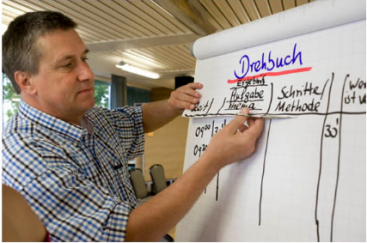Executive Summary
When planning a training or workshop, it is very important to develop an agenda. The training agenda should meet the identified training needs in format and content and structure the training goals. It helps the participants to have an overview on the course before it takes place. Also, the trainer can use the agenda to improve his time management.
Introduction

Developing an agenda for a workshop. Source: REGIOSUISSE (2009)
Whether you are planning a workshop or a meeting, there are a number of items that should always be included in your agenda, such as:
- a clear set of goals
- a way to gather the group
- breaks
- an opportunity for feedback and
- a way to close the session
It is especially true in training and professional development that having a good mix of presentations, discussions, and experiential activities is important to keeping the participants engaged.Also, an agenda helps the trainer with his time management. The following framework guides you through the process of preparing the training agenda.
Getting the Workshop Started
Agenda Preview and Goals: What is your overall plan for the session and what do you expect will happen as a result of your plans? (See also planning individual sessions) Make sure to include a review of your goals when you first present the agenda to the participants.
Gathering: What will you do to bring the group together? Use icebreakers? Has everyone answered some question or shared something? Have the participants talked about what they hope to accomplish? Gatherings can be simple and quick or they can begin to engage the group in the task at hand. For new groups, do something that gets people to begin learning one another's names. For groups that have been working together for a while you might include a game that will help people get to know one another better. Setting ground rules can also be an important part of getting the workshop started.
Training Activities and Transitions
Activities: These are the heart of your session. What activities will you include that will help create a positive emotional climate? Activities can include games, check-ins, singing, personal sharing, breaks, simulations, role plays, brainstorming, group works, etc. All activities should help support your goals and be appropriate for the group.
Breaks and Transitional Activities: Adult learning principles say that participants can generally understand material presented in 90 minutes, but will only retain material presented in twenty minutes. This information has important implications for training design. Along with taking frequent breaks, consider using quick, active exercises as mini-breaks. Even just standing and stretching can help get the group back on track when minds begin to wander.
Closing the Workshop
Feedback: At the end of each session it is a good idea to have the group to provide feedback on what worked and what didn’t work. This can be in writing on an training evaluation form or can be done in a group discussion. Make sure you write a report of the training workshop after it took place to improve future courses with the results of this one.
Closing: What will you do to end the session? A quick go-round with a word that describes what each individual learned? A cheer? Make sure to end the group on a positive note (see also energisers).
If you follow these suggestions, you can expect that your training will not only provide skill building and content knowledge, but will also improve the way your team functions together.
The training schedule should be planned after the needs assessment has been completed. Everyone who will be involved in the training should be involved in the planning. Make sure that you send out the training plan to all the participants well in advance so that they don’t miss the training. Type out your training plan on MS Word or Excel so it's a lot more organised.
See also time management.
Basic Training for Trainers
Train the Trainer: Basic Training Guidelines
An excellent training is nothing without an excellent trainer. This publication covers basic guidelines and tips to help improve your training skills. The following areas are covered: Preparation, Establishing Confidence, Setting the Tone, Facilitating Discussion, and Ending.
ALAMEDA COUNTY PUBLIC HEALTH DEPARTMENT (2007): Train the Trainer: Basic Training Guidelines. Alameda: Alameda County Public Health DepartmentDelivering Effective WASH Training
This Trainer Manual is to support people who facilitate Delivering Effective WASH Training (DEWT). It is based on the practical experience of the CAWST, the Centre for Affordable Water and Sanitation Technology.
CAWST (2015): Delivering Effective WASH Training. Alberta: Centre for Affordable Water and Sanitation Technology CAWST URL [Accessed: 19.08.2015]http://www.techrepublic.com/
Article explaining twelve steps to design effective training programs.
http://www.allbusiness.com/
A good collection of articles describing effective training management and skills required for the training.
http://www.fao.org/
Guidelines for trainers explaining how to create condition for trainings and what trainers should do to get the good atmosphere for the training.

